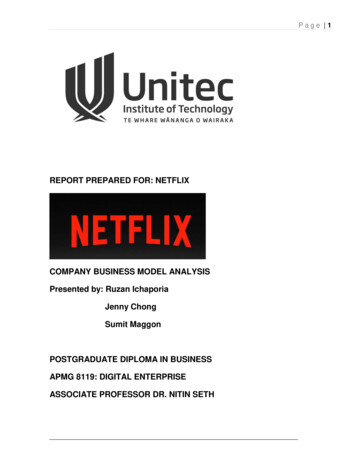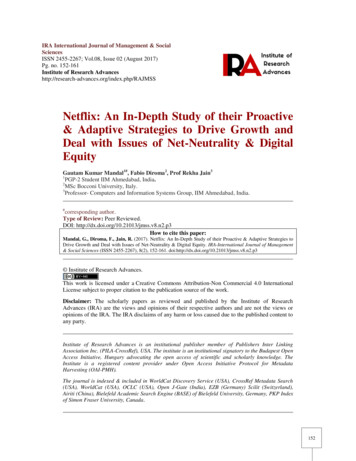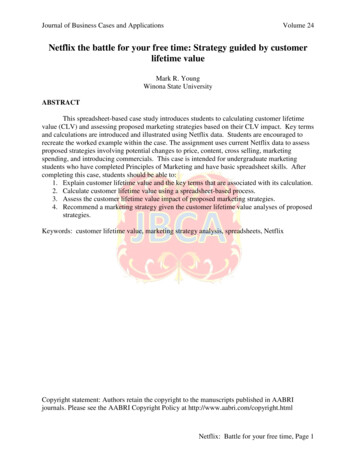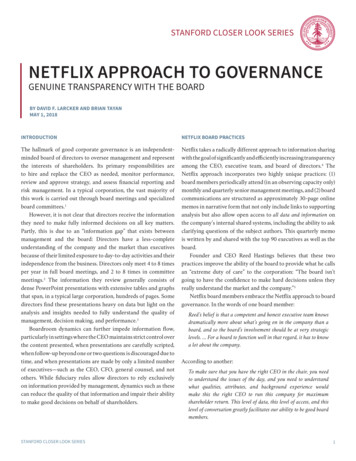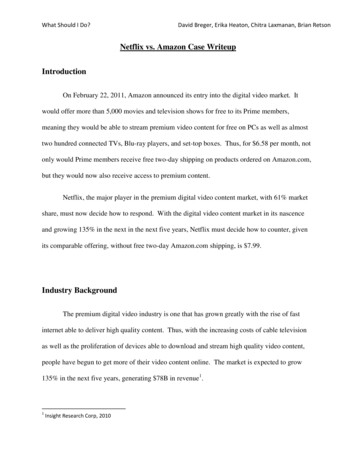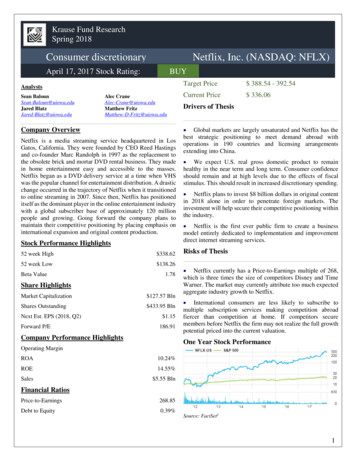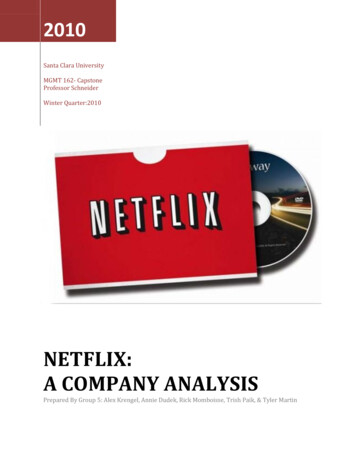
Transcription
2010Santa Clara UniversityMGMT 162- CapstoneProfessor SchneiderWinter Quarter:2010NETFLIX:A COMPANY ANALYSISPrepared By Group 5: Alex Krengel, Annie Dudek, Rick Momboisse, Trish Paik, & Tyler Martin
Table of ContentsI. Wall Street Journal Article and Executive Summary .4I A. Wall Street Journal Article 4I B. Executive Summary .5II. External Analysis .7II A. Industry Definition .7II B. Six Industry Force Analysis .8II C. Macro Environmental Forces Analysis, Economic Trends, and Ethical Concerns .15II D. Competitor Analysis .17II D. 1 Netflix’s Competitors .17II D. 2 Netflix’s Primary Competitors .17II D. 3 Primary Competitors’ Business Level and Corporate Level Strategy .18II D. 4 How Competitors Achieve Their Strategic Position .18II D. 5 Willingness to Pay .21II D. 6 Comparative Financial Analysis .22II D. 7 Implications of Competitor Analysis .23II E. Intra-Industry Analysis .24III. Internal Analysis .24III A. Business Definition/Mission .24III B. Management Style .24III C. Organizational Structure, Controls and Values .25III C. 1 Organizational Structure .25III C. 2 Organizational Controls .25III C. 3 Organizational Values .25III D. Strategic Position Definition .26III D. 1 Corporate Level .26III D. 2 Business Level .27III D. 3 Resource & Capability Level .28Value Minus Cost Profile .28Value Chain .28VRIO Analysis .28Consumer Retention Analysis .294Ps Analysis .29Product Life Cycle .30III E. Financial Analysis .31III E. 1 Netflix Financial Performance Analysis .31III E. 2 Valuation of Netflix .32III E. 3 Scenario Analysis .33IV. Analysis of the Effectiveness of the Strategy .34V. Recommendations .35V A. Short-Term and Long-Term Recommendations .35V A. 1 Short-Term Recommendations .35V A. 2 Long-Term Recommendations .36V B. Strategy Implementation .38V B. 1 Short-Term Strategy Implementation: Video Game Industry .38V B. 2 Long-Term Strategy Implementation: Streaming .38V C. Corporate Social Responsibility and Ethical Decision-Making Practices .39VI. Conclusions .39VII. Bibliography .402 Page
VIII. Main Appendix .43Exhibit 1: Video Entertainment Industry Diagram .43Exhibit 2: Average Weekly Hours of Consumption by Age .43Exhibit 3: Average Weekly Hours of Consumption by Age Chart .44Exhibit 4: Leisure Activities at Home, by Age .45Exhibit 5: Hours Available for Leisure per Week .46Exhibit 6: Industry Six Forces Analysis .47Complements . 47Threat of Entry .48Supplier Power .50Buyer Power .53Rivalry .55Substitutes .56Exhibit 7: Market Share (Retail and Rental) .57Exhibit 8: Market Share (Rental) .57Exhibit 9: Average Annual Sales Growth .58Exhibit 10: Average Gross Profit Margin .58Exhibit 11: Average Return on Assets .59Exhibit 12: Average Debt-to-Equity .60Exhibit 13: Current Ratio .60Exhibit 14: Average Collection Period .61Exhibit 15: Average Asset Turnover .61Exhibit 16: Average Inventory Holding Period .62Exhibit 17: Industry Financial Ratios .63Exhibit 18: Netflix, Inc. Organizational Chart .69Exhibit 19: BCG Matrix .69Exhibit 20: VRIO Framework .70Exhibit 21: Value Chain .71Exhibit 22: Netflix, Inc. 2008 Income Statement .71Exhibit 23: Cost of Debt/Cost of Equity .72Exhibit 24: WACC Weights .73Exhibit 25: Netflix, Inc. Income Statement Plus Warner Bros. Agreement Changes .74Exhibit 26: Cost of Debt/Cost of Equity .75Exhibit 27: WACC Weights .76Exhibit 28: WACC Calculation .78Exhibit 29: Capital Expenditure .79Exhibit 30: Net Working Capital .79IX. Financial Background Appendix .79IX A. Netflix Current Value 2008 .79IX A. 1 Justification of Approaches .79IX A. 2 FCF Analysis .80IX A. 3 Growth Metrics .82IX A. 4 Free Cash Flows .83IX B. Netflix Valuation Incorporating the Warner Bros. Deal .84IX B. 1 FCF Analysis .84IX B. 2 Growth Metrics .86IX B. 3 Free Cash Flows .883 Page
I. Wall Street Journal & Executive SummaryI A. Wall Street Journal ArticleUPDATE: Netflix, Warner Bros. Reach New DealBy David B. WilkersonJanuary 6, 2010Online DVD rental pioneer Netflix Inc. (NFLX) has reached a new deal with Warner Bros. HomeEntertainment that will make new Warner Bros. DVD and Blu-ray titles available for rental 28days after their release, the companies said Wednesday.The new agreement addresses the shifting preferences of consumers who appear morereluctant to buy DVDs in a shaky U.S. economy and a wider array of entertainment options.Terms of the latest deal also cover Warner Bros. titles made available for streaming to Netflixcustomers. Streaming is an increasingly important part of the company's strategy in the digitalage; the number of subscribers who streamed a movie or television episode from Netflix jumpedby 20% over the third quarter of last year.Warner Bros. Home Entertainment, owned by Time Warner Inc. (TWX), announced its intentionseveral months ago to renegotiate terms with Netflix. Time Warner Chief Executive Jeff Bewkestold investors in September that the previous deal's economics didn't "make sense" for thestudio.Most DVD sales come in the first weeks of a title's release. In October, Netflix CEO Reed Hastingssaid his company would not be opposed to a "sales-only" window of about a month at anystudio, as long as Netflix could reach favorable terms."We've been discussing new approaches with Warner Bros. for some time now and believewe've come up with a creative solution that is a 'win-win' all around," said Ted Sarandos, chiefcontent officer for Netflix, in a statement.Ron Sanders, president of Warner Bros. Home Entertainment, said "The 28-day window allowsus to continue making our most popular films available to Netflix subscribers while supportingour sell-through product."The weakened economy and the advent of 1 rentals, most notably from kiosks operated byCoinstar Inc.'s (CSTR) Redbox, have contributed to this trend towards fewer sales and morerentals.But because the majority of Netflix's shipments to customers are catalog titles, it is lessdependent on new releases than its DVD-based competitors. For that reason, the company isperhaps better positioned to adapt to a delayed-rental strategy faster than its rivals - mostpointedly, Redbox.Still, Netflix said Wednesday that its new agreement with Warner Bros. gives it better access tonew releases, which currently account for about 30% of its total shipments.4 Page
Netflix shares were up 3.2%, at 53.15 in late-afternoon trading Wednesday. TimeWarner stock was down marginally, at 29.04.I B. Executive SummaryNetflix Inc. is in the home video entertainment market, within the larger video entertainmentindustry. Horizontal markets include Airline, Hotel and Theater video entertainment markets.All four markets together make up the industry. Video rental and retail combined madeNetflix’s market worth 26.7 billion in 2008. (BBI) The market is segmented into a number ofstrategic groups, which include brick and mortar rental and sales, DVD vending kiosks, onlinerentals and sales, mail-delivery services, and video-on-demand services accessible through thetelevision.Due to rapid technology convergence, which characterizes the quality of the disruptivetechnologies, the rental portion of the market is changing from physical rentals to digital rentals,provided via streaming channels through broadband-connected set-top boxes, game consoles,and computers. All work to bring streaming content straight to the consumer’s television,making viewing interactive, easier, and available whenever the consumer wants it.Consumers may be broken into two segments, needy consumers and convenience consumers.Needy consumers are typically older, and less prone to using new technologies and arecommitted to watching specific programming, while convenience consumers are younger,watching video when they can, often utilizing technologies to access titles on their schedule.Netflix’s primary competitors are Blockbuster and Comcast. Blockbuster has the majority of themarket share (52 percent), Netflix has 13 percent, and Comcast has 3 percent. Netflix adds mostvalue to consumers through low capital and input costs, and through convenience of streamingvideo.For our comparative financial analysis, we took five years of data (from 2004 to 2008) andcompared competitors based on growth, profitability, leverage, liquidity, and efficiency. Netflixsaw the most growth on average (40.3 percent/year), whereas Blockbuster saw negativeaverage growth (- 2.16 percent/year). Blockbuster, Netflix, and Comcast all saw good positiveprofit margins, but in terms of efficiency Blockbuster and Comcast had return on assets belowthe industry average. Netflix is the most efficient out of these three companies, with an ROA of10.39 percent. Netflix also does not leverage its business with debt, whereas Blockbuster does.Blockbuster has an average debt-to-equity of 4.42, suggesting that it has a high credit defaultrisk if it continues to see negative growth.Our competitor analysis showed that the traditional Home Video Entertainment industry isreaching stasis. Netflix should continue its reach into streaming video, as consumer demand ismoving towards streaming.Netflix Inc. and Warner Bros. reached an agreement in January of 2010 regarding movie titleacquisitions. Within the agreement, Netflix Inc. (NFLX) has agreed to accept new titles 28 daysafter being released to the public. In return, Warner Bros. have agreed to provide Netflix withmore titles released later than five years ago and “straight-to-video” DVD, Blu-ray discs, andstreaming video that are currently not offered. Warner Bros. has agreed to continue ongoingnegotiations regarding price changes that will favor Netflix’s title acquisition prices.5 Page
The recent agreement between Netflix and Warner Bros. has many implications oneach company and the industry as a whole. By agreeing to receive new release titles 28days after being released, Netflix is surrendering access to newly released movies. New releases,according to Netflix comprise 25% of their current business. Warner Bros. hopes to see discsales increase as they have significantly decreased in a similar manner to iTunes versus CD sales.Netflix will also lose out on having access to new titles, potentially giving their competitors anadvantage on sales. Netflix, however, has received access to new titles that were released morethan five years ago as well as “straight-to-video” titles. By gaining access to more titles, Netflixhopes to expand business into new movies and become more competitive with large namevideo rental stores such as Blockbuster. Netflix is also in negotiations with receiving a pricedecrease from all Warner Bros. titles that is intended to lower their current operating margin byroughly 1.3% to match their target of 10%. Analysts feel that there is strong potential that thisdeal will lower customer satisfaction and hurt profitability. Netflix feels that achieving theirtarget operating margin will increase profitability of the company in years to come.Netflix’s business level strategy is on the physical distribution of movies and television titles tothe consumer, whereas on a corporate scale Netflix hopes to make a push into the streamingmarket by introducing more titles for the consumer to have access to. When looking throughNetflix VRIO we realized that Netflix has a sustainable advantage when it comes to their abilityto physically distribute their titles in a new and innovative way that creates added customerservice. They also have the upper hand when it comes to online streaming of content becausethey are the first movie distribution means that can stream directly onto your game console,computer and television. Netflix is currently positioned to make long and short-term moves inthe streaming market once they gain access to more titles. This will add to consumer retentionas well as bring in more consumers who will now have move access to movies than just theprevious means of physical distribution.Examining the strategic shift using a discounted cash flow and net present value techniqueshows that the deal with Warner Bros. will make Netflix more profitable. Using a moderategrowth forecast, as Netflix will begin to reach maturity in the business cycle, Netflix has anenterprise value of 2.16 billion USD before the Warner Bros. agreement. This leaves Netflixwith a fair market value of 35.48 per share. Implementing the deal with Warner Bros. hasseveral implications on the financials. As removed access to “New Release” titles will hurt somebusiness, revenue is forecasted to drop by 5% this upcoming year. The strategic move does yieldcost saving techniques. The valuation incorporates a 10% decrease in technology anddevelopment expenses as Netflix will not have to spend money and resources converting newtitles to streaming. A long term 25% decrease in the disposal of DVD’s was used as Netflix shiftstoward more streaming content, removing the physical inventory. With the changes that willoccur from the Warner Bros. deal, Netflix is estimated to have a value of 3.22 billion USD and afair market value of 52.97. Netflix will see significant value added by adding more titles,especially to their streaming catalogue.After analyzing Netflix internally and relative to the industry, Netflix appears to be in a goodposition regarding its deal with Warner Bros. The 28-day waiting period for new releases shouldnot harm their revenues as they move toward continuously increasing the size and popularity oftheir non-new release library. By making other strategic moves such as shifting power in theonline streaming industry, potentially internationally as well, and teaming with firms in thevideo game and smart phone industries, Netflix will greatly expand its sources of revenues. Themore Netflix grows, the less emphasis is placed on new release rentals. Therefore, the best way6 Page
to handle this new position is to expand in other industries and reach new markets asmuch as is wise and possible.II. External An
reaching stasis. Netflix should continue its reach into streaming video, as consumer demand is moving towards streaming. Netflix Inc. and Warner Bros. reached an agreement in January of 2010 regarding movie title acquisitions. Within the agreement, Netflix Inc. (NFLX) has agreed to accept new titles 28 days after being released to the public. In return, Warner Bros. have agreed to provide Netflix with

